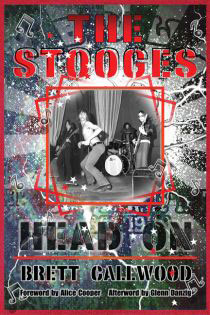The Stooges: Head On, By Brett Callwood
Published on December 5th, 2011 in: Book Reviews, Books, Dancing Ourselves Into The Tomb, Issues, Music, Reviews |
The Stooges are legendary, but that word implies events from long ago, where the facts are less important than romantic myths. At this point in time, Iggy Pop is famous, while The Stooges have always been more infamous than anything else. But even if your mom has heard of Iggy Pop, she may not know much about The Stooges. Brett Callwood’s book, Head On, seeks to enlighten those who don’t know much about the untold history of this essential and influential Detroit band who came into being well before the so-called punk movement of the mid-1970s.
Callwood’s book, first published in 2007, was originally titled Head On: A Journey Through The Michigan Underground. As a British journalist and fan, he chose to intertwine his story of discovery with the story of the band itself. For this North American edition he felt that a “traditional ‘biography’ approach” was more fitting and thus deleted much of that information.
Even so, the introduction to Head On tells of Callwood’s difficulties in tracking down the somewhat elusive members of the band: drummer Scott Asheton, his guitarist brother Ron, subsequent guitarist James Williamson, and Iggy Pop himself. There are many “friends of friends who knew people who knew people” types of situations. This reveals the Detroit music scene of the 1960s and ’70s to be a somewhat incestuous breeding ground for bands. Keeping track of all the names proves to be a challenge, but luckily Callwood provides an alphabetical index at the end of the book so we don’t get confused.
While there is quite a bit of input from Ron Asheton, Iggy Pop, James Williamson, and Stooges sax player Steve Mackay, there is not so much from Scott Asheton, who is known for not doing interviews. Still, Callwood provides plenty of background on how the various members met and started the band, including a particularly evocative section on the initial friendship between Ron Asheton and original Stooges bassist Dave Alexander.
Less explicit is any discussion of Alexander’s departure from the band in 1970. Iggy Pop says that Dave was the most “difficult” one to bring into the band in the beginning, but his leaving is barely addressed. One day he’s there, then James Williamson comes along, and we don’t hear about Dave until we find out about his death from alcohol-related causes in 1975. (According to well, everyone, but specifically Paul Trynka’s Iggy Pop biography Open Up and Bleed, Alexander was fired after a particularly disastrous show at Goose Lake in 1970.)
Even though alcohol and drug abuse contributed to the initial break up of the band, Head On is not a litany of fucked up behavior and stints in rehab like Anthony Kiedis’s Scar Tissue. If anything, all the members of the band—and many of their friends and associates—come across as genuine, no matter how legendary they may have become over the years.
As a testament to this, Chapter 10—which talks about the impact of Ron’s death in January 2009—is full of amazingly touching tributes by those who knew him. One cannot help but cherish his contributions to the band—and to music—as well as view him as a truly decent, gentle soul.
Ron Asheton is also highly praised for his musical accomplishments, which seem to have been overshadowed by Iggy Pop’s subsequent success. In the Foreword, Alice Cooper explains that while Ron may not have considered himself to be a great guitar player, he was an “authentic” one, saying that he “never played anything that didn’t need to be there.” Iggy is also meticulous in his complimentary descriptions of both Ron’s guitar style and Scott’s drumming technique.
Much of the book is devoted to both Ron and Scott Asheton’s post-Stooges musical pursuits (and in Ron’s case, B-movie pursuits) but there is definitely a sense of relief and happiness when the original Stooges (minus Alexander) reunite around 2003, thanks to J Mascis and Mike Watt, who were big fans of the band.
Tellingly, Ron Asheton refers to “that fateful call” from Iggy Pop but says, “My brother’s dream was always that The Stooges would get back together.” Iggy himself admits he was initially hesitant about reuniting the band, saying he associated them with “madness and obscurity” but that he missed the “feeling” (Original emphasis).
The legacy of The Stooges might be one of punk rock pioneers, but after reading Head On, particularly the earlier chapters, one realizes that they were more like art rock anarchists than anything else. They didn’t write the stereotypical two-minute punk anthems, preferring to just play music and see where it might take them. Only later did they learn how to write songs and play their instruments. But all the technical expertise in the world can’t make up for passion, the feeling you get when you hear The Stooges music, then or now. That feeling is a big part of why Head On is a great read.
The revised version of Head On was published by Wayne State University Press in September 2011 and is available through their website.
Time limit is exhausted. Please reload the CAPTCHA.